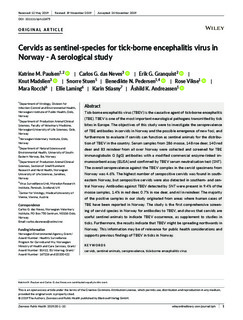| dc.contributor.author | Paulsen, Katrine Mørk | |
| dc.contributor.author | Das Neves, Carlos G | |
| dc.contributor.author | Granquist, Erik Georg | |
| dc.contributor.author | Madslien, Knut Ivar Engesæter | |
| dc.contributor.author | Stuen, Snorre | |
| dc.contributor.author | Pedersen, Benedikte Nevjen | |
| dc.contributor.author | Vikse, Rose | |
| dc.contributor.author | Rocchi, Mara | |
| dc.contributor.author | Laming, Eleanor | |
| dc.contributor.author | Stiasny, Karin | |
| dc.contributor.author | Andreassen, Åshild Kristine | |
| dc.date.accessioned | 2020-01-29T10:08:40Z | |
| dc.date.available | 2020-01-29T10:08:40Z | |
| dc.date.created | 2020-01-13T15:10:08Z | |
| dc.date.issued | 2019 | |
| dc.identifier.citation | Zoonoses and Public Health. 2019 . | nb_NO |
| dc.identifier.issn | 1863-1959 | |
| dc.identifier.uri | http://hdl.handle.net/11250/2638527 | |
| dc.description | This is an open access article under the terms of the Creative Commons Attribution License, which permits use, distribution and reproduction in any medium, provided the original work is properly cited. | nb_NO |
| dc.description.abstract | Tick‐borne encephalitis virus (TBEV) is the causative agent of tick‐borne encephalitis (TBE). TBEV is one of the most important neurological pathogens transmitted by tick bites in Europe. The objectives of this study were to investigate the seroprevalence of TBE antibodies in cervids in Norway and the possible emergence of new foci, and furthermore to evaluate if cervids can function as sentinel animals for the distribution of TBEV in the country. Serum samples from 286 moose, 148 roe deer, 140 red deer and 83 reindeer from all over Norway were collected and screened for TBE immunoglobulin G (IgG) antibodies with a modified commercial enzyme‐linked immunosorbent assay (ELISA) and confirmed by TBEV serum neutralisation test (SNT). The overall seroprevalence against the TBEV complex in the cervid specimens from Norway was 4.6%. The highest number of seropositive cervids was found in south‐eastern Norway, but seropositive cervids were also detected in southern‐ and central Norway. Antibodies against TBEV detected by SNT were present in 9.4% of the moose samples, 1.4% in red deer, 0.7% in roe deer, and nil in reindeer. The majority of the positive samples in our study originated from areas where human cases of TBE have been reported in Norway. The study is the first comprehensive screening of cervid species in Norway for antibodies to TBEV, and shows that cervids are useful sentinel animals to indicate TBEV occurrence, as supplement to studies in ticks. Furthermore, the results indicate that TBEV might be spreading northwards in Norway. This information may be of relevance for public health considerations and supports previous findings of TBEV in ticks in Norway. | nb_NO |
| dc.language.iso | eng | nb_NO |
| dc.rights | Navngivelse 4.0 Internasjonal | * |
| dc.rights.uri | http://creativecommons.org/licenses/by/4.0/deed.no | * |
| dc.title | Cervids as sentinel-species for tick-borne encephalitis virus in Norway - A serological study | nb_NO |
| dc.type | Journal article | nb_NO |
| dc.type | Peer reviewed | nb_NO |
| dc.description.version | publishedVersion | nb_NO |
| dc.rights.holder | © 2019 The Authors | nb_NO |
| dc.source.pagenumber | 10 | nb_NO |
| dc.source.journal | Zoonoses and Public Health | nb_NO |
| dc.identifier.doi | 10.1111/zph.12675 | |
| dc.identifier.cristin | 1771672 | |
| dc.relation.project | Interreg: 167226 | nb_NO |
| dc.relation.project | Interreg: 20200422 | nb_NO |
| dc.relation.project | Helsedepartementet: B1412 | nb_NO |
| cristin.unitcode | 222,58,1,0 | |
| cristin.unitname | Institutt for natur, helse og miljø | |
| cristin.ispublished | true | |
| cristin.fulltext | original | |
| cristin.qualitycode | 2 | |

